The Biggest Astronomy Stories of 2014
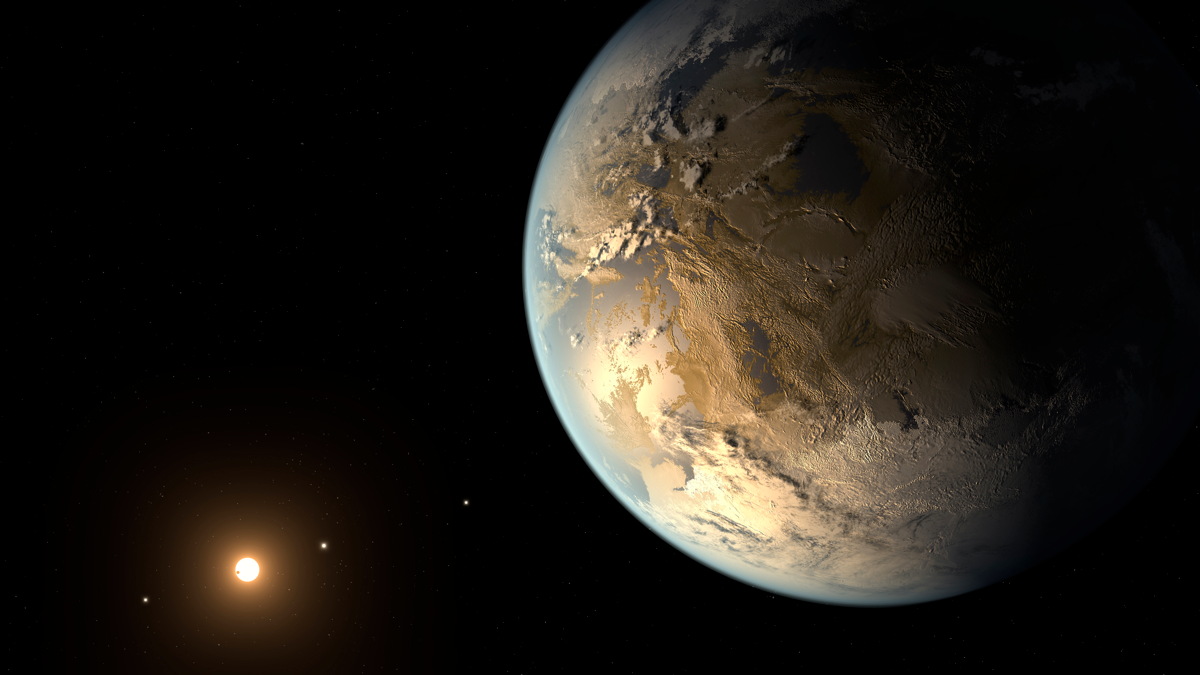
The year 2014 was a packed one for astronomical science.
Over the last 12 months, scientists made historic progress in the study of Mars, had two close encounters with comets, and may have found hints of dark matter and signals from the Big Bang. It's enough to make us eager for 2015 to see what new discoveries await.
But there are some stories that stand out from the crowd that was space science in 2014. Here is our list of the biggest astronomy stories of the year:
Historic year in Mars exploration
Tantalizing new information about the Red Planet, along with new clues about the possibility that it once supported life, was revealed this year. 2014 also happens to be the 50-year launch anniversary of the first probe ever sent to Mars.
In December, scientists working on the Mars rover Curiosity announced that the Red Planet hosts organic chemicals (those that contain carbon and are the building blocks of life on Earth). The chemicals chlorobenzene, dichloroethane, dichloropropane and dichlorobutane were discovered inside a rock that Curiosity drilled into in May 2013. Researchers stressed that their findings do not indicate that life exists or ever existed on Mars — but it does open the door of possibility.
In addition, scientists confirmed in December that the rover had detected methane on Mars, despite not finding any trace of methane last year. Living organisms on Earth are known to produce high levels of methane, so its presence on the Red Planet is another possible sign of life.
NASA's Mars Atmosphere and Volatile Evolution (MAVEN) spacecraft arrived at the Red Planet on Sept. 21, just in time to observe the flyby of Comet Siding Spring. The $671 million mission will focus on uncovering the events that changed the planet from a world with lakes and rivers, to a complete desert.
Get the Space.com Newsletter
Breaking space news, the latest updates on rocket launches, skywatching events and more!
Just two days after MAVEN, India's Mars Orbiter Mission (MOM) arrived at the fourth planet from the sun. The $74 million mission is India's first probe to reach Mars. MOM is carrying a camera (and has already snapped some stunning photos), and four scientific instruments that will study the planet's surface and atmosphere.
The swarm of activity around Mars came during the 50-year anniversary of the launch of the Mariner 4 spacecraft in 1964. Mariner 4 was the first probe to ever fly by Mars and the first mission to take up-close images of another planet from deep space. In celebration of the anniversary, the space-funding company Uwingu used radio telescopes to beam nearly 90,000 messages straight at the Red Planet.
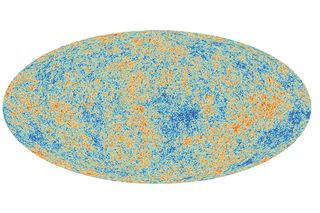
Big Bang discovery bites the dust
The BICEP2 collaboration grabbed headlines in March when it claimed to have found evidence that our universe rapidly expanded after the Big Bang, causing ripples in the fabric of the universe. By September, outside evaluation had thrown serious doubt on the findings.
BICEP2 (which stands for the Background Imaging of Cosmic Extragalactic Polarization) uses a telescope in Antarctica to detect the light left over from the Big Bang, called the cosmic microwave background (CMB). Patterns in that light that are very difficult to detect could indicate that the universe rapidly expanded shortly after the Big Bang and that the expansion created gravitational waves, or ripples in space-time.
In September, scientists working with the European Space Agency's (ESA) Planck satellite, which also studies the CMB, showed that what BICEP2 interpreted as patterns in the light could be nothing more than gas and dust in the Milky Way. The biggest cosmological finding of the 21st century seemed to crumble.
Now, BICEP2 and Planck will directly compare their data, to try to make a more definitive statement about the results. It is still possible that BICEP2's original interpretation is correct. [BICEP2 and the Origins of the Universe: Behind the Buzz]
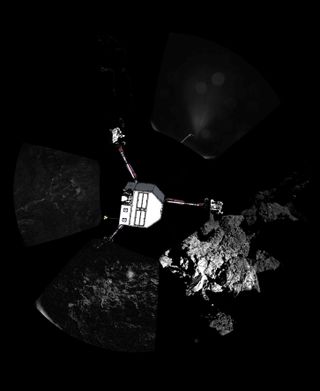
First touchdown on a comet
In a historic first, ESA landed a probe on a comet. The Philae lander managed to conduct a brief study of the space rock before it lost power and went into hibernation mode.
Philae's mother ship Rosetta spacecraft traveled for 10 years and about 4 billion miles (6.4 billion kilometers) to reach Comet 67P/Churyumov-Gerasimenko. In the early-morning hours of Nov. 12, Philae left Rosetta and traveled the remaining 317 miles (510 km) to the comet. Philae hit the target landing area, but harpoons meant to secure it to the surface did not deploy. Philae bounced twice before settling down for good.
Philae is solar-powered, and the region where it came to rest is in shadow. Unable to recharge, Philae is in hibernation mode.
Before Philae shut down, it did manage to conduct some science. Instruments aboard the lander detected organic molecules — those that contain carbon are a necessary ingredient of life on Earth — in the comet's composition. One of the probe's instruments also made an attempt at hammering into the surface of the comet and found it to be as hard as ice, according to ESA.
"This machine performed magnificently under tough conditions, and we can be fully proud of the incredible scientific success Philae has delivered," Philae lander manager Stephan Ulamec of DLR German Aerospace Agency said in an ESA blog post.
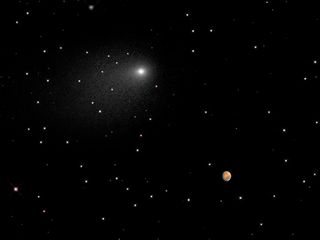
Mars Siding Spring encounter
Mars experienced a very rare close encounter with a comet in 2014. Comet Siding Spring came within 87,000 miles (139,500 kilometers) of the Red Planet, and left behind a shower of dust for scientists to study.
The five satellites currently orbiting Mars had to batten down the hatches, so to speak, and prepare for the comet to buzz by at a top speed of 126,000 mph (203,000 km/h) relative to the planet. In reality, the probes moved to the opposite side of Mars, which turned out to be a smart move: The comet dumped a few thousand kilograms (about 4,000 lbs.) of material on the planet — far more than scientists had anticipated.
The orbiters were able to study the effect of the massive dust dump, which "literally changed" the Martian atmosphere, according to Jim Green, head of NASA's Planetary Science Division. Scientists say the dust contained high levels of sodium, which would likely have given the sky a yellowish hue as it fell through the Martian atmosphere and burned up. Early analyses also detected iron, zinc, potassium, manganese, nickel and chromium. The dust also contained high levels of magnesium, which was a significant contrast to the Martian atmosphere. [Mars Myths & Misconceptions: Quiz]
A comet flies this close to Mars approximately once every 8 million years, according to Green. "We've got a lot of research going on and it's going to be at least another year before all the results are in."

Earth-size planet found in the habitable zone
For the first time, scientists identified an Earth-size planet in the habitable zone of its parent star. The "Earth cousin" could have liquid water and, potentially, the right conditions for life.
The new planet, called Kepler-186f, is less than 10 percent larger than Earth, and orbits a red dwarf star. Red dwarfs are smaller and dimmer than our sun, but the planet still lies in the star's habitable zone — a distance at which the planet could have a surface temperature at which water would remain a liquid.
Kepler-186f is the outermost of five planets orbiting the star Kepler-186, located about 490 light-years from Earth. Scientists think it could be a rocky planet, but they don't yet know if Kepler-186f has an atmosphere suitable for life. As planets become more massive, they become more likely to resemble gas giants like Jupiter, rather than terrestrial planets like Earth and Mars.
Kepler-186f was discovered by the Kepler space telescope. In February, scientists with the Kepler mission announced that they had discovered more than 700 new exoplanets — more than doubling the number of confirmed exoplanets.
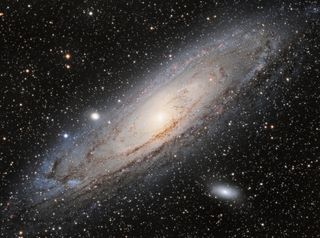
Dark-matter signal detected?
It's possible that years from now, 2014 will be remembered as the year dark matter was first detected.
Researchers using data from ESA's XMM-Newton spacecraft reported finding a mysterious X-ray signal coming from both the Andromeda galaxy and the Perseus galaxy cluster. The signal doesn't correspond to any known matter, and the researchers say that one plausible explanation is dark matter.
Dark matter has never been directly detected by scientists (that remains true until the signal from XMM-Newton is confirmed as dark matter). It does not emit, reflect or absorb light (hence the name "dark" matter). But scientists estimate that dark matter makes up 80 percent of the matter in our universe, and it exerts a measureable gravitational force on regular matter like stars and galaxies.
The XMM-Newton results haven't garnered the kind of attention from the scientific community that one might expect for the discovery of the century. Researchers say there are still alternative explanations for the mysterious signal.
Scientists don't know what dark matter is made of, but there are multiple candidate particles. The new results would indicate that dark matter is made of a particle called an axion. Other dark-matter searches are looking for particles called weakly interacting massive particles, or WIMPs.
This year, the U.S. Department of Energy and the U.S. National Science Foundation approved funding for three next-generation dark-matter experiments, which will all be at least 10 times more sensitive than current detectors. The hope is that once these experiments are up and running, an answer to the dark-matter puzzle will be just around the corner.
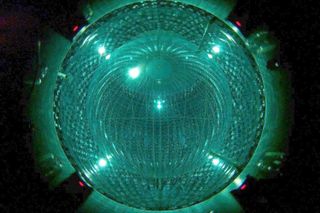
Solar neutrinos
Scientists are not yet able to look directly into the heart of the sun, but the detection of particles that are produced in the burning core may be the next best thing.
Scientists with the Borexino experiment at Gran Sasso National Laboratory near L'Aquila, Italy, announced in August that they had detected ghostly little particles called neutrinos, produced in the fusion process that keeps the sun burning. The detection confirms scientists' current understanding of stellar fusion.
Neutrinos are particles that pass through regular matter more than 99 percent of the time. Billions of them pass through the palm of your hand every second.
Scientists first detected neutrinos coming from the sun in the 1960s, but those were produced by different processes taking place in Earth's nearest star and tended to have higher energies than the newly detected neutrinos. With higher energies, neutrinos are generally more likely to interact with matter (like a particle detector) and, as a result, are easier to detect.
Because neutrinos rarely interact with regular matter, they escape from the sun instantly, and provided a direct line between the core of the sun and scientists on Earth. Andrea Pocar, of the University of Massachusetts, Amherst and part of the Borexino team, told Space.com by email in August that the neutrinos "allow us to look at the majority of the fusion reactions in the sun's core in real time, as they happen, minus an 8-minute delay for travel to Earth."
The researchers say these particular neutrinos could help them answer other questions, like how neutrinos spontaneously change "flavors."
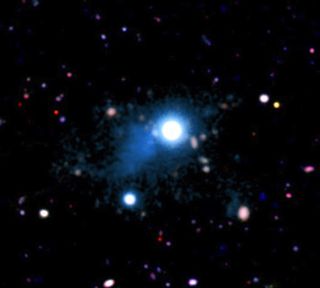
First glimpse at the cosmic web
This year, scientists got a glimpse at one of the largest structures ever observed in our universe: a thread of the cosmic web, stretching 2 million light-years across the universe.
At very large scales, our universe may resemble a spider web, with long strings of gas stretched between galaxies, connecting them together. This cosmic web hypothesis goes well with theory, but scientists had not seen the intergalactic threads directly until this year.
Using the Keck telescope in Hawaii, the researchers studied the light from an intensely bright object called a quasar, which happened to be pointed at such an angle that it lit up the gas thread between two galaxy nodes. Quasars are powered by material surrounding supermassive black holes, and they shine brighter than all the stars in their host galaxy combined.
"The quasar is illuminating diffuse gas on scales well beyond any we've seen before, giving us the first picture of the extended gas between galaxies," J. Xavier Prochaska, of the University of California, Santa Cruz, said in January. "It provides a terrific insight into the overall structure of the universe."
The results could also help scientists study the distribution of dark matter in the universe. The distribution of regular matter is believed to mirror that of dark matter, so where tendrils of gas are found, dark matter may lurk as well.

Total lunar eclipse tetrad begins
2014 was a good year for skywatchers: It featured two total lunar eclipses, in which the moon dips entirely into the shadow of the Earth and takes on a deep red shade. Two more complete lunar eclipses will take place in 2015, for a total of four in a row, which is known as a lunar tetrad.
The eclipses took place on April 15 and Oct. 8, and were visible in all or part of North and South America. The next two will take place on April 4, 2015, and Sept. 28, 2015, and will be visible in all or part of the United States.
There are three kinds of lunar eclipses, according to NASA: penumbral eclipses, in which the moon passes through the outer portion of the Earth's shadow and very little change occurs in the way the moon looks in the sky; a partial eclipse, in which the moon passes partly through the core of the Earth's shadow so part of it is darkened; and a total eclipse, in which the moon is totally consumed by the Earth's shadow and turns a deep shade of red.
Eclipses occur roughly twice per year, but there is no particular pattern in what type of lunar eclipse will occur. While eight lunar tetrads will occur in the 21st century, there were no tetrads between 1600 and 1900. NASA scientists say it is also rare for all four eclipses to be visible in the United States.
Follow Calla Cofield @callacofield. Follow us @Spacedotcom, Facebook and Google+. Original article on Space.com.
Join our Space Forums to keep talking space on the latest missions, night sky and more! And if you have a news tip, correction or comment, let us know at: community@space.com.

Calla Cofield joined Space.com's crew in October 2014. She enjoys writing about black holes, exploding stars, ripples in space-time, science in comic books, and all the mysteries of the cosmos. Prior to joining Space.com Calla worked as a freelance writer, with her work appearing in APS News, Symmetry magazine, Scientific American, Nature News, Physics World, and others. From 2010 to 2014 she was a producer for The Physics Central Podcast. Previously, Calla worked at the American Museum of Natural History in New York City (hands down the best office building ever) and SLAC National Accelerator Laboratory in California. Calla studied physics at the University of Massachusetts, Amherst and is originally from Sandy, Utah. In 2018, Calla left Space.com to join NASA's Jet Propulsion Laboratory media team where she oversees astronomy, physics, exoplanets and the Cold Atom Lab mission. She has been underground at three of the largest particle accelerators in the world and would really like to know what the heck dark matter is. Contact Calla via: E-Mail – Twitter











